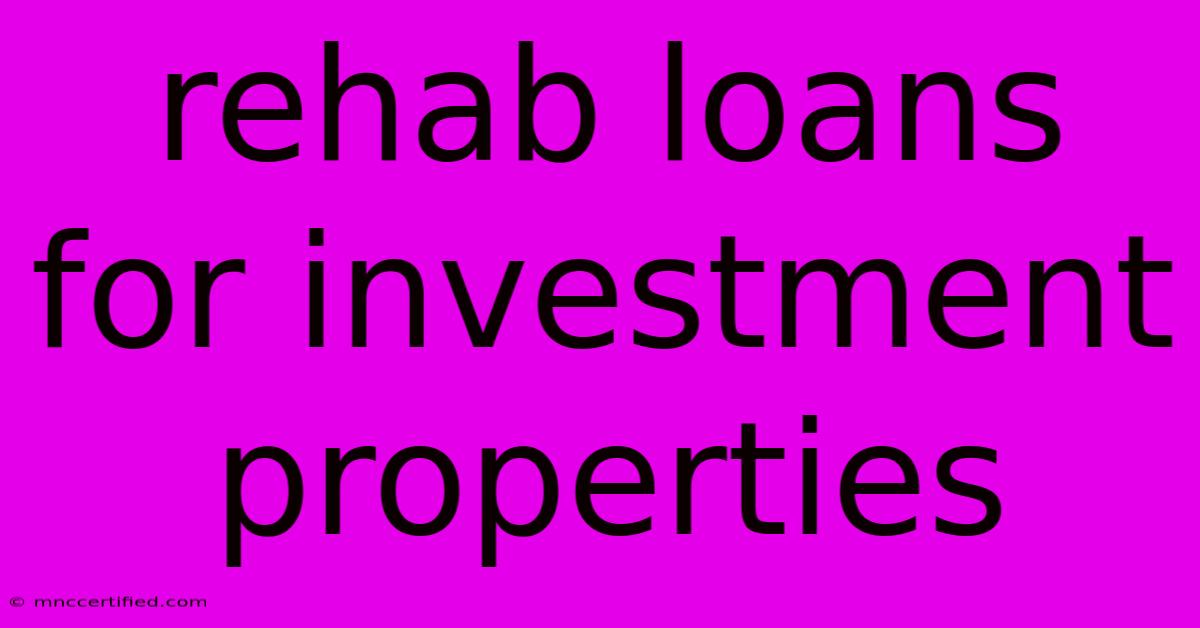Rehab Loans For Investment Properties

Table of Contents
Rehab Loans for Investment Properties: Unlock Your Next Flip or Rental
Are you an experienced real estate investor looking to take on a fixer-upper? Or perhaps you're a seasoned landlord with a vision for a property upgrade? If you're planning to purchase an investment property that needs some love, rehab loans can be your ticket to success.
These specialized loans cater to the unique needs of investors, providing the necessary funds to not only purchase the property but also cover renovation costs. But navigating the world of rehab loans can seem daunting. This guide breaks down the key aspects of rehab loans for investment properties, covering everything from eligibility requirements to different loan types, helping you make informed decisions.
Understanding Rehab Loans
Rehab loans, also known as fix-and-flip loans or construction-to-permanent loans, are specifically designed for properties that require renovation or rehabilitation. Unlike traditional mortgages, they offer a single loan that covers both the purchase price of the property and the cost of repairs. This streamlined approach simplifies the financing process and allows you to focus on your project.
Who are Rehab Loans For?
Rehab loans are ideal for investors with a proven track record in real estate. They're typically sought by:
- Fix-and-flip investors: These investors buy properties, renovate them, and quickly resell them for a profit.
- Rental property owners: Landlords use rehab loans to upgrade their existing rentals, increase their value, and attract better tenants.
- Investors seeking to transform distressed properties: Rehab loans can be a solution for buying properties in need of significant repair or renovation.
Types of Rehab Loans
There are a few different types of rehab loans to consider, each with its own set of terms and conditions:
- Construction Loans: These loans provide funds in stages as the renovations progress, ensuring you have access to money as needed.
- Fix-and-Flip Loans: These loans are specifically designed for short-term projects where the goal is to quickly renovate and sell the property.
- Bridge Loans: Bridge loans are short-term loans that provide temporary financing while you wait for a long-term loan to be approved.
- Construction-to-Permanent Loans: These loans combine a construction loan with a permanent mortgage, offering a seamless transition from construction to ownership.
Key Benefits of Rehab Loans
Rehab loans offer several advantages for investment property owners:
- Simplified Financing: You can secure financing for both purchase and renovation, avoiding multiple loan applications.
- Flexibility: Rehab loans allow for staged drawdowns, providing funds as you complete specific stages of the renovation.
- Higher Loan Amounts: Rehab loans often offer higher loan amounts than traditional mortgages, allowing you to take on larger projects.
- Potential for Higher Returns: Rehab loans can help you unlock the hidden potential of distressed properties, leading to increased returns on your investment.
Navigating Rehab Loan Requirements
To qualify for a rehab loan, you'll typically need to meet certain criteria, including:
- Credit Score: A strong credit score is essential, as lenders want to ensure you are a responsible borrower.
- Down Payment: You'll need a down payment, usually a higher percentage than a traditional mortgage, to cover the purchase price and initial renovation costs.
- Experience: Lenders often require proven experience in real estate investing, demonstrating your ability to manage projects.
- Property Appraisal: A qualified appraiser will determine the property's value after renovations are complete.
- Detailed Renovation Plans: You'll need to provide detailed plans outlining the scope of the renovations and associated costs.
Tips for Success with Rehab Loans
To maximize your chances of securing a rehab loan and achieving your investment goals, consider these tips:
- Start with a Solid Investment Plan: Thoroughly research potential properties and develop a detailed plan that includes realistic renovation costs and market projections.
- Get Pre-Approved: Speak with several lenders to compare rates, terms, and eligibility requirements before you make an offer on a property.
- Choose the Right Loan Type: Carefully assess your project's timeline and financing needs to determine the best type of rehab loan for your situation.
- Maintain Open Communication: Stay in close contact with your lender throughout the renovation process, providing regular updates on progress and expenses.
The Bottom Line
Rehab loans can be a valuable tool for real estate investors looking to unlock the potential of fixer-uppers or upgrade their rental properties. By understanding the different loan options, meeting eligibility requirements, and following best practices, you can harness the power of rehab loans to achieve your investment goals and maximize your returns. Remember, consulting with an experienced mortgage broker can be invaluable in navigating the complexities of rehab financing and finding the right loan for your specific needs.

Thank you for visiting our website wich cover about Rehab Loans For Investment Properties. We hope the information provided has been useful to you. Feel free to contact us if you have any questions or need further assistance. See you next time and dont miss to bookmark.
Featured Posts
-
Texas Contractor Bonding Requirements
Nov 10, 2024
-
Supplementary Payments Auto Insurance
Nov 10, 2024
-
Helen Flanagans Real Hair Before Extensions
Nov 10, 2024
-
Anna Bondar Vs Ella Seidel Prediction
Nov 10, 2024
-
Galaxy Investment Partners California
Nov 10, 2024